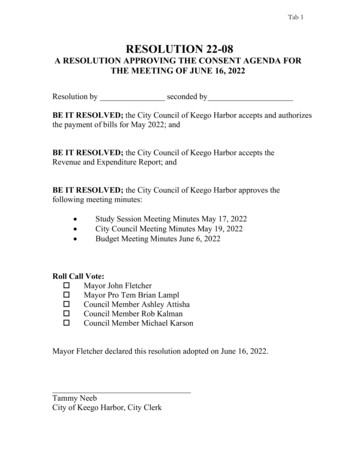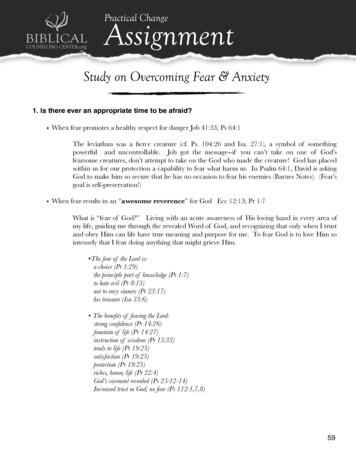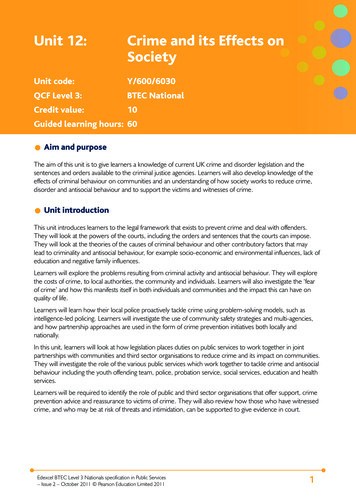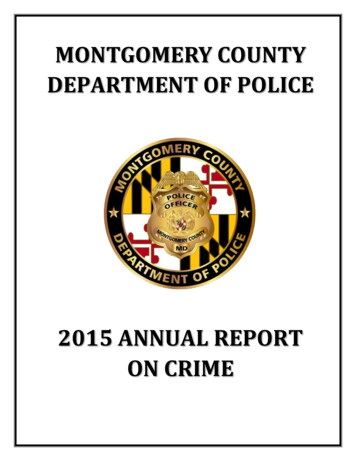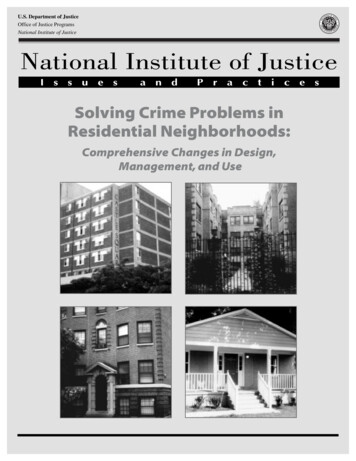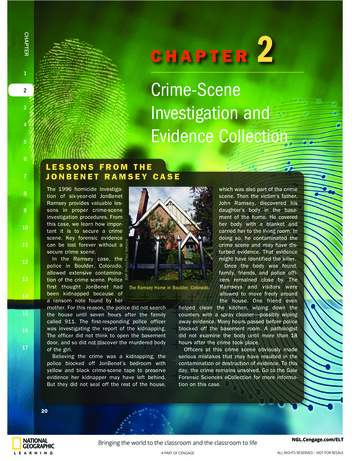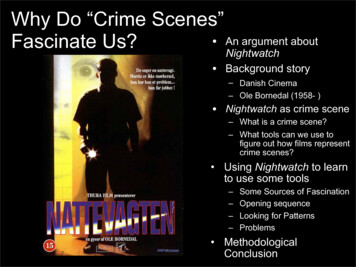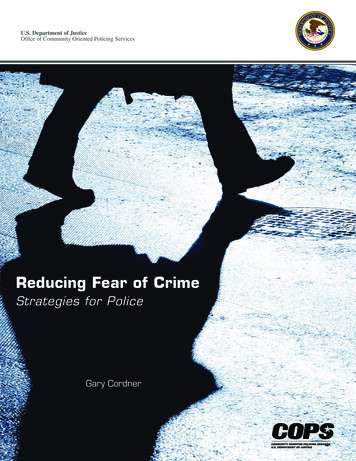
Transcription
U.S. Department of JusticeOffice of Community Oriented Policing ServicesReducing Fear of CrimeStrategies for PoliceGary Cordner
Reducing Fear of CrimeStrategies for PoliceGary CordnerKutztown UniversityJanuary 2010
This project was supported by Grant Number 2003-CK-WX-K049 awarded by the Office of Community OrientedPolicing Services, U.S. Department of Justice. The opinions contained herein are those of the author and do notnecessarily represent the official position or policies of the U.S. Department of Justice. References to specificagencies, companies, products, or services should not be considered an endorsement by the authors or theU.S. Department of Justice. Rather, the references are illustrations to supplement discussion of the issues.The Internet references cited in this publication were valid as of July 2009. Given that URLs and web sites are inconstant flux, neither the authors nor the COPS Office can vouch for their current validity.
Letter from the DirectorDear Colleagues,Fear of crime has an incredibly corrosive effect on individuals and entire communities. Thisissue is of great concern to all of us in law enforcement. Fear negatively shapes all aspects ofthe quality of life of America’s communities.The COPS Office recognizes that people not only need to be safe, but they also need tofeel safe. Treating both of these issues as two parts of a greater whole is a critical aspectof community policing. That is why we produced this document, “Reducing Fear of Crime:Strategies for Police.” This publication identifies promising practices that have the potential todirectly address the fear of crime. It is written by Gary Cordner, one of the foremost expertson the issue of community fear in the policing field.Community policing is one of the most effective tools for reducing the fear of crime. Whenlaw enforcement works directly with residents and businesses within a community, they aregoing a long way toward reducing crime, improving quality of life, and enhancing public safety.I know that you will find our new publication, “Reducing Fear of Crime: Strategies for Police,”extremely useful.Sincerely,Bernard K. MelekianDirectorCOPS Officeiii
Executive SummaryExecutive SummaryFear of crime was at or near the top of the list of police priorities in the United States morethan 2 decades ago, in the early 1980s. Many police executives had accepted the premise thatreducing fear of crime was an important objective, and several promising practices had beenidentified. This situation helped spur the development of community policing in the 1980s and1990s but, paradoxically, the importance of fear of crime within the explicit missions of mostpolice departments seemed to recede even as community policing expanded. More recently,however, the gap between (1) falling crime rates and (2) stable or even increasing levels of fear(what some call the reassurance gap) has led to renewed interest among police in strategiesfor reducing fear of crime. Also, fear of terrorism arose in America post-9/11, making fearreduction even more salient for local, state, and national officials.This Guide briefly reviews information about the phenomenon of fear of crime as well ashistorical and contemporary police efforts to reduce fear. The main focus, however, is on toolsand techniques that police can use to target and reduce fear of crime, and institutionalizefear reduction within their agencies. Some promising practices and best practices have beenidentified—these are strategies and programs that have been implemented and that have beentested and shown to be effective.Fear of crime is a different animal from crime, disorder, or traffic, but it is not really all thatesoteric. This Guide will help police understand what fear of crime is, why it matters, and whyit should be an important target of police attention. The Guide provides a number of tools andtechniques that should enable any police department to successfully add fear reduction to itsoperational strategy and organizational bottom line.v
AcknowledgmentsAcknowledgmentsPreparation of this Guide was supported by the Office of Community Oriented PolicingServices (the COPS Office) and entailed a national survey, site visits, and extensive reviewof documents, reports, articles, and books. The author would like to express sincere thanksto the many experts and officials who provided information, advice, and support during theproject, including Matt Lysakowski of the COPS Office; Kentucky Regional Community PolicingInstitute colleagues Cindy Shain, Ed Brodt, and Tracy Schiller; the research staff at EasternKentucky University’s Justice & Safety Center, including AnnMarie Cordner, Emily Raine, TaraRose, Jacinda Bertie-Cockerham, and Jan Mays; Mora Fiedler previously of the Denver PoliceDepartment; Pat McElderry of the Colorado Springs Police Department (retired); Dr. MartinInnes, University of Surrey; and Gavin Stephens, Home Office, United Kingdom. Special thanksgo to Sergeant Neil Henson of the London Metropolitan Police who helped provide access tohis own agency as well as other officials and agencies in England.vii
IntroductionIntroductionFear of crime has a huge impact on American society. Individuals often choose where tolive, shop, and socialize based on their perceptions of the relative safety of different cities,towns, and neighborhoods. Parents allow their their kids to play in the park or walk to schoolif they think it would be safe. Neighborhoods and entire cities have gone into spirals ofdecline because fear of crime motivated those residents and businesses who could afford tomove, to do so. Fear of crime routinely drives local politics, occasionally influences nationalelections, and has been the catalyst for vastly increased federal crime-control efforts sincethe 1960s. Concern about heightened fear of crime in the 1980s and 1990s helped spur thedevelopment of community policing. Since the 1990s, the actual level of crime has fallendramatically, but fear of crime has not seemed to recede as quickly or as substantially.This Guide argues in favor of including fear reduction (making people feel safer) among theexplicit components of the modern police mission. It is based on the following interrelatedassumptions: Fear matters—it negatively affects individuals and communities. Fear is real—while it is just a feeling, fear affects behavior, politics, economics, andsocial life. Admittedly, fear is not as important as crime—the harm caused by fear shouldnot be equated with the tangible and often tragic harm caused by violent crime orsignificant property crime. But fear is very important—while making people safe is perhaps the most importantpurpose of government, making them feel safe is nearly as important because fear hassuch negative ramifications for politics, economics, and social life. Reducing fear is and should be a police responsibility—the important governmentpurpose of making people feel safe falls to the police logically and of necessity. Police can reduce fear—promising fear-reduction strategies and practices have beendeveloped and tested in the past 30 years. Reducing fear should be an explicit police priority—unless police specificallytarget fear of crime, their attention tends to get distracted toward other issues, and fearreduction efforts are neglected. Fear-reduction efforts should be targeted—the preponderance of the evidence onpolice effectiveness in general is that more targeted strategies work best. This generalprinciple applies to the specific challenge of reducing fear of crime.ix
Reducing Fear of Crime: Strategies for PoliceThis Guide briefly reviews information about the phenomenon of fear of crime as well ashistorical and contemporary police efforts to reduce fear. The main focus, however, is on toolsand techniques that police can use to target and reduce fear of crime, and institutionalizefear reduction within their agencies. Some promising practices and best practices have beenidentified—these are strategies and programs that have been implemented and that have beentested and shown to be effective.Targeting Fear. Police departments need to begin measuring and analyzing fear of crimemore systematically. During the past few decades, police have learned that they need crimeanalysis to target crime—the same goes for fear of crime. This often requires both communitywide and neighborhood-level surveys, but those are not the only methods for learning aboutfear. Community meetings, key individuals, environmental audits, and routine public contactscan also serve as very useful sources to learn about the concerns and worries of communityresidents. Once police have some information about fear of crime in the community, theycan use it to identify demographic groups that are most affected, neighborhoods where fearis the highest, and other trends and patterns. Police can also identify anomalies, such asneighborhoods where crime is low but fear is high. Armed with data and analysis about fear ofcrime, police can begin to focus and target their attention, just as they do with crime itself.Reducing Fear. Once fear problems are identified and understood, the key is to applyresponses tailored to those problems. If the source of a neighborhood’s fear is poor streetlighting, a community newsletter is not going to fix it. If the cause of fear is aggressivepanhandlers in a shopping district, then showing homeowners how to put better locks on theirdoors will not work. This Guide strongly recommends tailored responses—specific to the natureand causes of fear of crime as revealed through information and analysis. In conjunction withthis kind of problem solving, implementing more personalized policing and encouraging morecommunity engagement are recommended, since both have generally been associated withmaking the public feel safer. Then there is one more crucial ingredient—feedback. People willnot become less fearful unless they know that the sources of their fear have been addressed.Fear is based on perception, so police intent on reducing fear have to follow through andmake sure that the public sees, hears about, or otherwise recognizes when problems have beenfixed, conditions improved, etc. This is so important that police departments should also beginthinking more about the larger function of strategic communication. Police need to becomemore sophisticated purveyors of reassurance as an antidote to the inevitable messages ofmayhem and fear that predominate in politics and the media.x
IntroductionInstitutionalizing Fear Reduction. The final section of this Guide considers how fearreduction might be more firmly cemented into the ongoing operations of police agencies. Onekey step is to formally acknowledge that fear reduction is part of the mission and bottom lineof policing. Another is to permanently implement systems for measuring and tracking fear ofcrime so that lack of data cannot be an excuse for lack of targeting. Besides, in policing “whatyou measure is what you get.” Along this line, fear reduction should be built into CompStatlike systems of command accountability—area commanders should know that making theirresidents feel safer is one of their obligations, and one of the criteria upon which theirperformance will be judged. The same goes for beat-level sergeants and officers—if they knowthat they will be held accountable for addressing fear of crime in their neighborhoods, they willmore likely take it seriously. Moreover, this is a very reasonable aspect of accountability sincemany fear problems are neighborhood-based, and we know from 25 years of broken windowsand community policing that neighborhood residents really appreciate it when beat officerstarget disorder, incivilities, and other causes of neighborhood anxiety and fear.Fear of crime is a different animal from crime, disorder, or traffic, but it is not really all thatesoteric. This Guide will help police understand what fear of crime is, why it matters, and whyit should be an important target of police attention. The Guide provides a number of tools andtechniques that should enable any police department to successfully add fear reduction to itsoperational strategy and organizational bottom line.xi
ContentsExecutive Summary . . . . . . . . . . . . . . . . . . . . . . . . . . . . . . . . . . . . . . . . . . . . . . . . . . . vAcknowledgments . . . . . . . . . . . . . . . . . . . . . . . . . . . . . . . . . . . . . . . . . . . . . . . . . . . . viiIntroduction . . . . . . . . . . . . . . . . . . . . . . . . . . . . . . . . . . . . . . . . . . . . . . . . . . . . . . . . . ix1 Why Target Fear? . . . . . . . . . . . . . . . . . . . . . . . . . . . . . . . . . . . . . . . . . . . . . . . . . . 1The Case for Targeting Fear. . . . . . . . . . . . . .Arguments Against Targeting Fear of Crime. .Counterarguments. . . . . . . . . . . . . . . . . . . . .Fear Reduction in Perspective. . . . . . . . . . . .About Fear of Crime. . . . . . . . . . . . . . . . . . .About This Project . . . . . . . . . . . . . . . . . . . .14568122 Police Strategies for Reducing Fear. . . . . . . . . . . . . . . . . . . . . . . . . . . . . . . . . . . . . 15How Policing Might Reduce Fear. .Crime Prevention . . . . . . . . . . . . .Community Policing. . . . . . . . . . .Broken Windows . . . . . . . . . . . . .Problem-Oriented Policing . . . . . .15181820213 Tools for Targeting Fear. . . . . . . . . . . . . . . . . . . . . . . . . . . . . . . . . . . . . . . . . . . . . . 25Community Surveys . . .Community Meetings . .Key Individuals. . . . . . .Environmental Audits. .Routine Contacts. . . . . .Reassurance Matrix. . . .2632343739404 Tools for Reducing Fear. . . . . . . . . . . . . . . . . . . . . . . . . . . . . . . . . . . . . . . . . . . . . . 45Personalized Policing . . . .Community Engagement. .Environmental Design. . . .Problem Solving. . . . . . . .Direct Feedback. . . . . . . .Strategic Communication. .4547505255585 Tools for Sustaining Fear Reduction. . . . . . . . . . . . . . . . . . . . . . . . . . . . . . . . . . . . . 65Including Fear Reduction in the Police Mission. . . . . . . .Measuring and Tracking Fear . . . . . . . . . . . . . . . . . . . . .Including Fear in Crime Analysis and Problem Analysis. .Command Accountability for Fear Reduction. . . . . . . . . .Beat-Level Accountability . . . . . . . . . . . . . . . . . . . . . . . .6566676769References. . . . . . . . . . . . . . . . . . . . . . . . . . . . . . . . . . . . . . . . . . . . . . . . . . . . . . . . . . 71Appendixes. . . . . . . . . . . . . . . . . . . . . . . . . . . . . . . . . . . . . . . . . . . . . . . . . . . . . . . . . . 79Appendix 1: National Survey Instrument. . . . . . . . . . . . . . . . . . . . . . . . . . . . . . . . . . 79Appendix 2: COPE Community Survey . . . . . . . . . . . . . . . . . . . . . . . . . . . . . . . . . . . 80Appendix 3: COPE Interview Guide. . . . . . . . . . . . . . . . . . . . . . . . . . . . . . . . . . . . . . 81xiii
Chapter 1: Why Target Fear?1Why Target Fear?Because fear of crime is just a feeling, some might wonder why it is important, particularly as atarget for police action. Certainly, crime itself must be more important than mere feelings aboutcrime? And even if fear of crime is of some importance, what can police be expected to do about it?The Case for Targeting FearOne expert who has studied fear of crime for more than 2 decades is Wesley Skogan ofNorthwestern University. He has also studied and evaluated police strategies, includingChicago’s experiment with community policing beginning in 1993. He makes the case forpaying attention to fear of crime as follows (2006: 255):Fear of crime is a social and political fact with concrete consequences for big-citylife. The costs of fear are both individual and collective. Fear can confine peopleto their homes, and it undermines their trust in their neighbors and, especially,in their neighbors’ children. Fear is a key “quality of life” issue for many people.Research also indicates that concern about crime has bad consequences for theneighborhoods in which we live. Fear leads to withdrawal from public life, and itundermines informal and organized efforts by the community to control crime anddelinquency. It is difficult to organize activities in neighborhoods where peoplefear their own neighbors. Fear undermines the value of residential property andthus the willingness of owners to maintain it properly. When customers—andeven employees—fear entering a commercial area, the viability of businesseslocated there is threatened.Most significant, in Chicago as elsewhere, fear of crime has been one of the most importantfactors driving residents to the suburbs, encouraging race and class segregation andundermining the political importance of American cities.1
Reducing Fear of Crime: Strategies for PoliceOfficials in England who have studied fear of crime and how to reduce it have expressedsimilar concerns (Fear of Crime Team, 2005: 16):Fear of crime is something that may affect people from all walks of life at anystage of their lives. This makes it different from actual crime which tends to beconcentrated on particular areas, victims and committed by a small number ofoffenders. Whether it is an older person who feels nervous about walking home,parents who feel anxious about sending their child up the road to buy sweets, ora shop keeper who tenses up every time a customer enters their shop, if we let it,fear of crime can have a devastating effect on our quality of life.Local and national surveys in the United States verify the public’s concern about crime andfear of crime. In a 2007 study in Charlotte, North Carolina, 46 percent of respondents said theywere somewhat worried or very worried about becoming a crime victim (Manware, 2007). Oneyear later in Charlotte, 42 percent of residents said they felt less safe than in 2007, while only7 percent felt safer (Cherrie, 2008). Nationwide in 2006, 37 percent of Americans said therewas an area within a mile of their home where they would be afraid to walk alone at night(Saad, 2006). This measure had peaked at 48 percent in 1982, then gradually fell to 30 percentin 2001 before beginning to go back up. Consistent with this trend in fear of crime, 71 percentof Americans in 2007 believed there was more crime in the United States than the year before,and 51 percent believed that crime in their local areas had increased in the past year (Saad,2007). Both of these measures of the perceived level of crime have increased since 2001.Figure 1. Crime Perceptions vs. Violent Crime.Source: Saad, Lydia. “Worry About Crime Remains at Last Year’s Elevated Levels.” GallupNews Service, 2006. s-Last-YearsElevated-Levels.aspx#1.2
Chapter 1: Why Target Fear?Figure 2. Is There More Crime in the U.S. Than There Was a Year Ago, or Less?Source: Saad, Lydia. “Worry About Crime Remains at Last Year’s Elevated Levels.” GallupNews Service, 2006. s-Last-YearsElevated-Levels.aspx#1.Increases in fear of crime and perceived levels of crime in the United States as measured byGallup Polls since 2001 are not consistent with the national trend in crime as measured byeither personal victimization (Rennison, 2002; Catalano, 2006) or reported crime (FederalBureau of Investigation, 2002 and 2007):Violent crime -18% change in the victimization rate (2001–2005) -6% change in the reported crime rate (2001–2006).Property crime -8% change in the victimization rate (2001–2005) -9% change in the reported crime rate (2001–2006).This kind of disconnect between the public’s perceptions versus actual levels of crime is notnew or even surprising, but it has certainly frustrated law enforcement officials during the pastdecade, when crime drops have not been matched by drops in fear of crime (Burke, Sandoval,and Lemire, 2009). The disconnect also frustrates incumbent political leaders, who want thevotes of reassured residents, at the same time that it provides fodder for their opponents (Stilesand Glenn, 2007). This situation is not unique to the United States—England (Fear of CrimeTeam, 2005), the Netherlands (Lasthuizen, Van Eeuwijk, and Huberts, 2005), and other countrieshave had similar experiences during the same time period. Still, recognizing that fear of crimeis a problem does not necessarily mean that it is a police problem or that reducing fear shouldbe a high priority. Several good arguments have been advanced for and against the inclusion offear reduction among the important missions of a police agency.3
Reducing Fear of Crime: Strategies for PoliceFigure 3. Victimization Rates for Violent Crime and Property Crime, 1993 2005.Each vertical bar shows the range within which the true victimization rate was likely to fall.For discussion of displaying estimates, see www.ojp.usdoj.gov/bjs/pub/pdf/cv05.pdf.Source: Catalano, Shannan. Criminal Victimization 2005. Washington, D.C.: Bureau of Justice Statistics, nts Against Targeting Fear of CrimeThe case for targeting fear has been outlined above, albeit briefly—fear matters, it is real, andit deeply affects individuals and communities. Furthermore, police should accept responsibilityfor fear reduction because they are the experts on crime and disorder, they are alreadyengaged with individuals and communities, and no one else has the expertise or authority toseriously tackle fear of crime.Arguments have been raised, though, against the idea of fear reduction as a police priority. Themost important of these arguments are noted below: Fear of crime is too ephemeral—it is too vague a concept and too intangible aproblem to deserve targeted attention. Fear of crime is a political tool—politicians and police manipulate the public’sanxiety about crime for their own purposes. Fear reduction is risky—people who are made to feel safer may “drop their guard”and engage in riskier behaviors, making them more susceptible to crime.4
Chapter 1: Why Target Fear? Fear reduction wastes resources—police should use their limited resources to tackleactual crime, which is more important than fear of crime. Fear reduction is a cop out—police started targeting fear at a time when it wasbelieved that there was nothing police could do to reduce actual crime. That time haspassed, and evidence now shows that police can reduce actual crime. The way to reduce fear is to reduce crime—perhaps fear of crime is important,but it is simply a reflection of actual crime, so it does not require any special ortargeted attention.CounterargumentsCompared with the arguments in support of police adopting fear reduction as an important partof their mission, these criticisms are not persuasive. However, each one contains a few grains ofinsight that should be incorporated into any law enforcement agency’s fear-reduction effort.1. Fear is vague, it is a feeling, and it is intangible, but it has behavioral and tangibleconsequences as previously noted. With careful effort, it can be defined and measured withreasonable accuracy. Once measured, it can be targeted and tracked so that fear-reductionefforts are logical, rational, and accountable.2. National and local politicians have been known to promote law and order agendas inresponse to the public’s fear of crime, and to stoke fears as a way of garnering more electoralsupport (Lee, 2007; Simon, 2007). Police agencies sometimes play to the public’s fear ofcrime when making their case for more resources or increased authority. It should come asno surprise that an important and emotional public issue such as fear of crime has politicalramifications. But so do crime, drugs, gangs, terrorism, police use of force, immigration, anda variety of other public safety matters. Just because fear of crime can be a hot political issuedoes not negate the fact that it has real consequences for people and communities.3. A certain amount of fear is an important survival and defense mechanism (Warr, 2000).The key is to keep the level of fear in proper balance with the actual level of risk. Risklevels vary for different individuals depending on their age, sex, occupation, and othercharacteristics. Also, risk levels vary between different neighborhoods. Consequently, fearreduction efforts should not be aimed naively at eliminating fear of crime, but rather atsynchronizing fear with actual levels of crime.4. Fear reduction does take resources (although it might also save resources if it leads to areduction in calls for service). It is important to consider fear reduction among the prioritiesof the police, without any claim that it is the only important priority (Moore and Braga, 2003).Logically, fear of crime might be a more serious problem in some communities than in others,and therefore fear reduction might be a higher priority for some police agencies than for others.5
Reducing Fear of Crime: Strategies for Police5. It is true that police began paying explicit attention to fear of crime in the early 1980s whenthere was a sense that police could do nothing to reduce actual crime. Crime seemed to haveincreased throughout the 1970s, and the first wave of police evaluation research concludedthat the traditional strategies of routine preventive patrol, rapid response, and reactiveinvestigation had no impact on the level of crime or on much of anything else (Cordner andScarborough, 2007: 383–397). Also, it is true that subsequent experience and research nowprovide evidence to support the view that more targeted, more community oriented, and moreproblem-oriented police strategies are more effective (Skogan and Frydl, 2004).The flaw in this particular argument against police targeting fear of crime is that it presentsa false dichotomy. In the current situation, which is different from the early 1980s, it is notnecessary to argue for a focus on fear reduction instead of crime reduction. Rather, we canrecognize that reducing crime and reducing fear are both worthy goals. Strategies can beemployed to attempt to achieve each goal. The priority of each may vary, and in fact it isreasonable to assume that reducing crime will be the higher of these two priorities for thevast majority of law enforcement agencies. The most useful way to think about it, though, isin terms of relative priorities, not either/or.6. Fear of crime is related to actual crime, but the connection is less clear-cut than might beassumed. The most fearful individuals are not necessarily those who have suffered themost crime or who are most at risk of victimization. The most fearful communities arenot necessarily the ones with the most crime. Fear of crime does not necessarily go upor down in correlation with the amount of actual crime and so on. Because fear of crimeis not highly correlated with actual crime, it cannot be assumed that reducing crime willreduce fear of crime—this has certainly been demonstrated by recent experience. It followsthat, if police want to reduce fear of crime, they may need to do other things in addition towhatever they do to try to reduce actual crime.When law enforcement agencies plan and implement fear-reduction strategies, they should keepthese counterarguments in mind. Police need to work smart in fear reduction just as much as theyneed to work smart when tackling crime and disorder. Fear of crime is simply another problemon the list of problems that police should address. It may be less tangible than some others,and it may not have the same sort of vocal constituencies of victims and relatives that crime,drug offenses, or drunken driving have. But fear of crime has such negative consequences forindividuals and communities that police must make sure that it gets targeted attention.Fear Reduction in PerspectiveWe have argued that fear reduction should be one of the priorities of the police. This naturallybrings up the larger question of overall police priorities, or in other words, what are the thingsthat police agencies should try to achieve—what are their goals? This important question hasbeen discussed and debated at leas
Concern about heightened fear of crime in the 1980s and 1990s helped spur the development of community policing. Since the 1990s, the actual level of crime has fallen dramatically, but fear of crime has not seemed to recede as quickly or as substantially. This Guide argues in favor of including fear reduction (making people feel safer) among the

